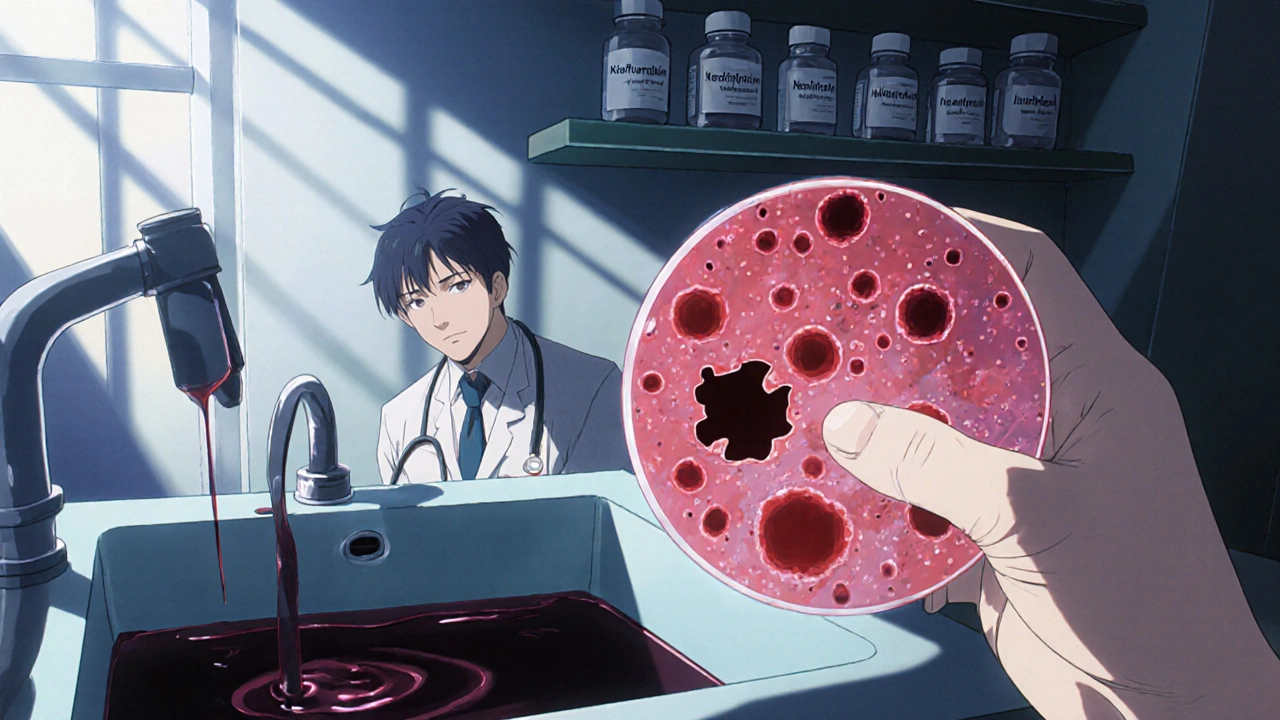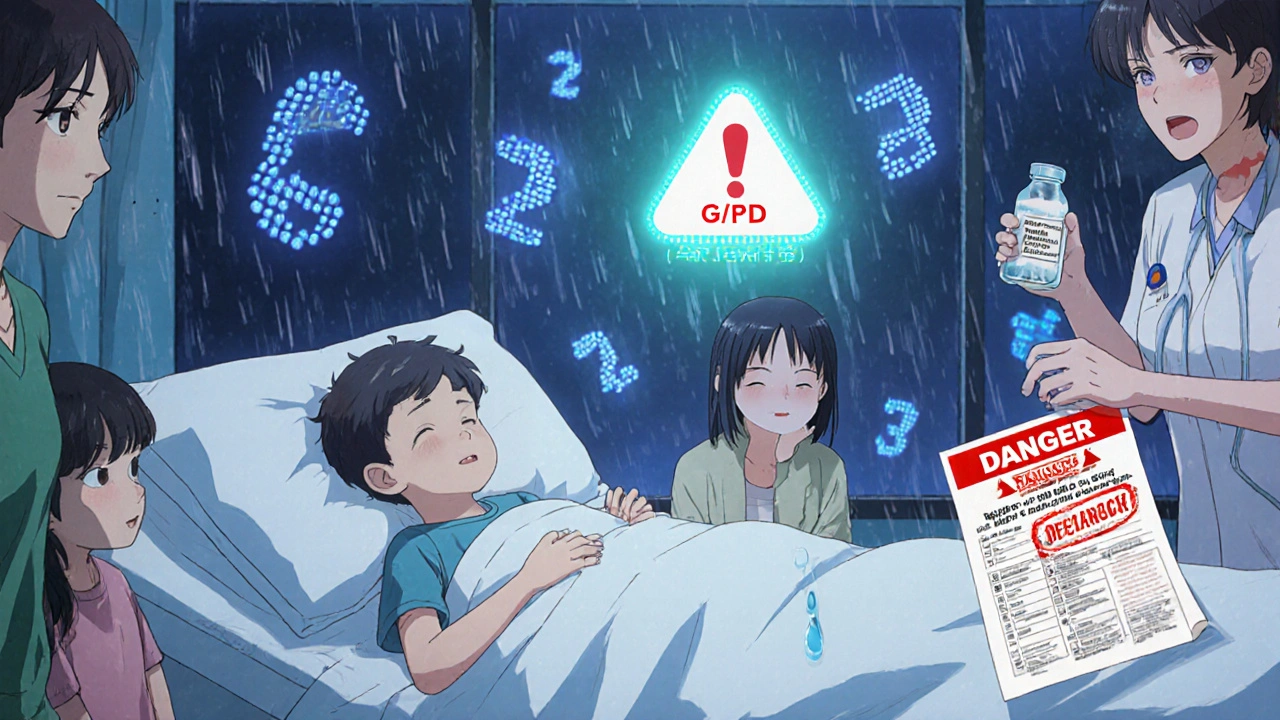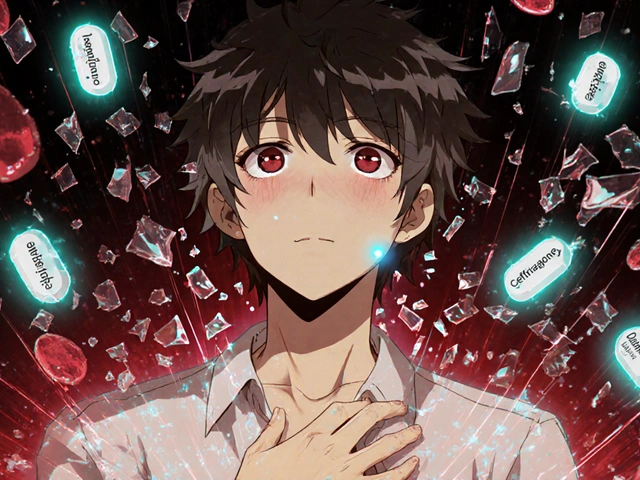
Medication Hemolytic Anemia Risk Checker
Check Your Medication Risk
This tool assesses the risk of drug-induced hemolytic anemia based on your medication, ethnicity, and age.
When a medication turns your own body against you, it’s not just a side effect-it’s a medical emergency. Hemolytic anemia from medications happens when drugs trigger your immune system to destroy your red blood cells. This isn’t a slow, quiet decline. It’s a rapid, invisible attack that can drop your hemoglobin by 5 points in just a few days. You might feel tired, short of breath, or notice your skin turning yellow. But unless you know what to look for, it’s easy to miss.
How Medications Trigger Red Blood Cell Destruction
Not all drug-induced hemolytic anemia works the same way. There are two main paths: immune-mediated and oxidative.In immune-mediated cases, the drug sticks to your red blood cells like a tag. Your immune system sees that tag as foreign and sends antibodies to destroy the cells. This is why drugs like ceftriaxone, cefotetan, and piperacillin are top culprits-they’re cephalosporins, a class that accounts for about 70% of immune-mediated cases. Even after you stop taking the drug, antibodies can linger and keep attacking. That’s why symptoms often show up 7 to 10 days after starting the medication.
Oxidative hemolysis is different. Here, the drug doesn’t trigger antibodies. Instead, it overwhelms your red blood cells’ ability to handle stress. Think of it like rust forming inside the cell. When your body can’t reduce iron properly, hemoglobin breaks down into clumps called Heinz bodies. This is especially dangerous if you have G6PD deficiency-a genetic condition that affects 10-14% of African American men and 4-15% of people of Mediterranean descent. Even if you don’t know you have it, drugs like dapsone, phenazopyridine, or nitrofurantoin can trigger a sudden, severe drop in red blood cells within 24 to 72 hours.
Which Medications Are Most Likely to Cause This?
The list of offenders is longer than most people realize. Cephalosporins are the biggest group, but they’re not alone. Here are the most common drugs linked to hemolytic anemia:- Cefotetan, ceftriaxone, piperacillin (third-generation cephalosporins)
- Methyldopa (historically common, now rarely used)
- Nitrofurantoin
- Dapsone
- Phenazopyridine (Pyridium)
- Levofloxacin
- NSAIDs like ibuprofen or naproxen (in rare cases)
- Penicillin and related antibiotics
- Primaquine and sulfa drugs (especially dangerous in G6PD deficiency)
- Topical benzocaine (used in throat sprays or dental gels)
What’s surprising is how many of these are common prescriptions or over-the-counter drugs. A patient might take phenazopyridine for a UTI, or ibuprofen for a headache, never suspecting it could trigger a life-threatening reaction. And because symptoms often appear days after starting the drug, it’s easy to blame something else.
What Symptoms Should You Watch For?
The signs aren’t always dramatic. Fatigue and weakness are the most common-reported in over 90% of cases. But here’s what to pay attention to:- Pale skin or yellowing of the skin and eyes (jaundice)
- Shortness of breath, even with mild activity
- Rapid heartbeat (over 100 beats per minute)
- Dark urine (like tea or cola)
- Back or abdominal pain
In severe cases, hemoglobin can drop below 6 g/dL in just 48 hours. That’s when the heart starts struggling. Studies show 8% of patients with sudden, severe hemolytic anemia develop heart failure. Arrhythmias and cardiomyopathy are real risks when oxygen delivery crashes.
Children are less likely to get this condition, but when they do, it’s often more severe. One 2023 study found pediatric cases averaged a hemoglobin of 5.2 g/dL-much lower than the adult average of 6.8 g/dL. That’s why any child with unexplained anemia and recent drug exposure needs urgent evaluation.

How Doctors Diagnose It
There’s no single test. Diagnosis requires connecting the dots between symptoms, medication history, and lab results. Here’s what clinicians look for:- Elevated indirect bilirubin (above 3 mg/dL)-from broken-down hemoglobin
- High LDH (above 250 U/L)-a marker of cell destruction
- Low haptoglobin (below 25 mg/dL)-it binds free hemoglobin and gets used up
- Peripheral smear-looking for spherocytes (in immune cases) or Heinz bodies (in oxidative cases)
- Direct antiglobulin test (DAT)-positive in 95% of immune-mediated cases, but can be negative early on or with certain drugs
Here’s the catch: if you test G6PD levels during active hemolysis, you might get a false negative. That’s because the test measures enzyme activity in older red blood cells-and those are the ones being destroyed. Newer cells (reticulocytes) still have normal G6PD. The real test should wait 2 to 3 months after the episode.
And here’s another problem: 43% of cases are misdiagnosed at first. Doctors might think it’s infection, liver disease, or another type of anemia. That’s why a detailed medication history is non-negotiable. Every drug, even topical ones, matters.
What Happens If You Don’t Stop the Drug?
Continuing the medication is like pouring gasoline on a fire. Hemolysis doesn’t slow down-it accelerates. The more red blood cells you lose, the harder your heart has to work. Without intervention, you risk permanent heart damage, kidney failure from hemoglobin clogging the filters, or even death.And there’s another hidden danger: clotting. People with DIIHA often go into a hypercoagulable state. A 2023 study found 34% of severe cases developed blood clots-deep vein thrombosis or pulmonary embolism-despite being anemic. That’s why doctors may give blood thinners even when the patient looks pale and weak.

How It’s Treated
The first and most critical step? Stop the drug. Immediately. No exceptions.Once you do that, most people start to recover within 7 to 10 days. Hemoglobin levels typically bounce back to normal in 4 to 6 weeks. But recovery isn’t automatic-it depends on how bad the damage was.
For severe anemia (hemoglobin below 7-8 g/dL), a blood transfusion is needed. But it’s not a simple fix. Transfused blood can still be attacked by lingering antibodies. That’s why matching the right blood type and monitoring closely is essential.
Corticosteroids like prednisone are sometimes used, but their benefit is unclear. Many patients recover without them once the drug is gone. For cases where antibodies keep attacking even after stopping the drug, treatment gets more aggressive:
- Intravenous immunoglobulin (IVIG)-1 gram per kg per day for two days
- Rituximab-375 mg/m² weekly for four weeks
- Azathioprine or cyclosporine-for long-term immune suppression
Studies show 78% of these refractory cases respond within 3 to 6 weeks. Newer drugs like efgartigimod (used in trials NCT05678901) are showing promise, with 67% of patients responding in just four weeks.
If methemoglobinemia is present (blue-tinged skin, low oxygen despite normal breathing), methylene blue is given. But here’s the critical warning: never give methylene blue to someone with G6PD deficiency. It can trigger massive hemolysis. Always check G6PD status before using it.
What You Can Do to Stay Safe
If you’ve had hemolytic anemia from a drug before, you’re at risk for it again. Keep a list of all medications that caused problems. Share it with every doctor, pharmacist, and ER provider.If you’re of African or Mediterranean descent, ask about G6PD testing-even if you’ve never had symptoms. Many people live their whole lives unaware they’re at risk.
When starting a new drug, especially antibiotics or pain relievers, pay attention to how you feel in the first week. If you get unusually tired, your skin turns yellow, or your urine darkens, don’t wait. Call your doctor immediately.
Hospitals are starting to use electronic alerts that flag high-risk drugs for patients with known risk factors. In places where these systems are in place, severe cases have dropped by 32%. Technology helps-but your awareness saves lives.
Can You Recover Fully?
Yes. Most people make a full recovery if the drug is stopped early. The body replaces red blood cells quickly-about 2 million per second. But recovery isn’t guaranteed if the damage was too severe or if treatment was delayed.Long-term complications are rare if managed correctly. But if you’ve had heart strain or kidney injury, follow-up care matters. Don’t assume you’re fine just because you feel better.
And remember: this isn’t something you can ignore or self-diagnose. If you suspect drug-induced hemolytic anemia, get tested. The labs don’t lie. And the sooner you act, the better your chances.
Can over-the-counter drugs cause hemolytic anemia?
Yes. Even common OTC drugs like phenazopyridine (Pyridium) for urinary discomfort or topical benzocaine in throat sprays can trigger oxidative hemolysis, especially in people with G6PD deficiency. NSAIDs like ibuprofen have also been linked in rare cases. Never assume a drug is safe just because it’s available without a prescription.
How long after taking a drug does hemolytic anemia start?
It depends on the mechanism. Immune-mediated cases usually take 7 to 10 days after starting the drug, because your body needs time to make antibodies. Oxidative hemolysis can happen within 24 to 72 hours, especially in people with G6PD deficiency. If you’ve taken the drug before and had no reaction, don’t assume it’s safe-the first exposure can sensitize your immune system.
Is hemolytic anemia from drugs more dangerous than other types?
It can be. The danger comes from how fast it progresses. Unlike iron-deficiency anemia, which develops over months, drug-induced hemolysis can crash your hemoglobin in days. That sudden oxygen drop puts immense stress on your heart and kidneys. Also, because it’s often missed, treatment is delayed-making outcomes worse.
Can I take the same drug again if I didn’t have a reaction before?
No. Even if you took a drug before without issue, you can develop an immune response the next time. Your body may have been sensitized during the first exposure. Once you’ve had drug-induced hemolytic anemia, avoid the drug for life. Document it in your medical records and carry a warning card.
Are children at risk for this condition?
It’s rare in children, but when it happens, it’s often more severe. Kids can present with hemoglobin levels as low as 5.2 g/dL, compared to 6.8 g/dL in adults. Because symptoms like fatigue or pale skin are easy to dismiss in children, this condition is frequently missed. Any child with unexplained anemia and recent antibiotic or painkiller use needs urgent evaluation.



So... let me get this straight: the government lets Big Pharma pump out these death-traps, and then they wonder why people are dropping like flies?!! I’ve been saying this for YEARS-every cephalosporin is a Trojan horse, and they’re all laced with nanotech that hijacks your hemoglobin!! I mean, have you seen the patents?? They’re literally coding your RBCs to self-destruct!! And don’t even get me started on the G6PD data… it’s all fabricated to hide the real culprit: fluoridated water + 5G resonance!! I’m not paranoid-I’m PREPARED. Bring me the bloodwork. I’ll show you the patterns. . . . . .
As a hematologist-in-training, I can confirm the immune-mediated mechanism is classically IgG-mediated with positive DAT in >90% of cases-but the real kicker is the delayed kinetics. The drug-hapten theory explains why ceftriaxone is the #1 offender: its long half-life and biliary excretion create persistent antigenic stimulation. What’s underreported is the role of complement activation via the alternative pathway-recent 2024 studies show C3d deposition even in DAT-negative cases. Also, the 34% clotting risk? That’s due to von Willebrand factor release from damaged endothelium. Bottom line: stop the drug, monitor LDH and haptoglobin q24h, and don’t assume G6PD is safe just because the test is negative during acute phase. You need a reticulocyte count >10% to rule out bone marrow suppression.
OMG I JUST TOOK PHENAZOPYRIDINE FOR MY UTI 😱 AND NOW I FEEL SO WEAK AND MY URINE IS DARK LIKE COFFEE?? IS THIS IT?? AM I GONNA DIE?? 😭😭😭 MY MOM SAID I SHOULD JUST DRINK MORE WATER BUT NOW I THINK SHE’S A BIG PHARMA SPY 😭😭😭 PLS HELP I’M SCARED 😭
It’s wild how we treat drugs like they’re harmless candy. We don’t think twice about popping ibuprofen or a throat spray, but our blood cells are tiny living things that get caught in crossfire. Maybe the real issue isn’t just the drugs-it’s how disconnected we’ve become from our own bodies. We outsource our health to pills and skip the quiet listening. If you feel off after a new med, don’t shrug it off. Your body’s whispering. Listen before it screams.
It is imperative that clinicians maintain a high index of suspicion for drug-induced immune hemolytic anemia, particularly in patients presenting with unexplained anemia and recent exposure to cephalosporins or sulfonamides. The diagnostic triad of elevated indirect bilirubin, low haptoglobin, and elevated LDH remains foundational. Moreover, the direct antiglobulin test, while not universally sensitive, remains the cornerstone of immune-mediated confirmation. Patients must be counseled regarding lifelong avoidance of implicated agents, and pharmacists should be integrated into the medication reconciliation process to mitigate future risk. This is not merely a clinical observation-it is a systemic safety imperative.
Okay so here’s the thing nobody wants to admit-this isn’t even about the drugs. It’s about the FDA being asleep at the wheel. I mean, phenazopyridine? That’s literally a dye that turns your pee orange, and they let you buy it next to aspirin? And G6PD deficiency? We’ve known about it since the 1950s, yet 80% of people in the US still don’t get tested unless they’re hospitalized with a crisis. And don’t even get me started on how they market antibiotics like they’re candy. It’s a scam. Big Pharma doesn’t want you to know that your body’s immune system is basically a fire alarm that got wired to a bomb. They profit off the explosion. I’ve been saying this for a decade. No one listens. But now? Now you’ve got the data. You’re reading it. You know. And that’s the first step. The rest? We’ll have to burn it all down to fix it.
OMG I JUST READ THIS AND I’M CRYING 😭 I’M G6PD DEFICIENT AND I TOOK NITROFURANTOIN LAST MONTH AND FELT TERRIBLE BUT THOUGHT IT WAS JUST ‘STRESS’ 😭 THANK YOU FOR WRITING THIS!! I’M TELLING EVERYONE I KNOW!! 🙏❤️ #G6PDawareness #DontIgnoreTheSymptoms
This is exactly why we need better patient education. You can’t just dump a 2000-word medical treatise on someone and expect them to understand. Break it down. Make it visual. Show them the hemoglobin drop curve. Compare it to a car running on empty. Tell them: if you feel worse after a new pill, stop. Call. Don’t wait. Don’t Google. Don’t assume it’s ‘just fatigue.’ Your body isn’t being dramatic-it’s screaming for help. And if you’ve had this once? Never take that drug again. Period. You’re not being paranoid. You’re being smart. And if your doctor doesn’t get it? Find someone who does. Your life depends on it.
USA got the best healthcare system in the world so why are we even talking about this? In China they just give you a shot and you get better. Here we got 10 tests, 3 specialists, and a 3 week wait. And now we’re scared of ibuprofen? Get a grip. If you can’t handle a little hemolysis you shouldn’t be alive. This is why America is weak. We overthink everything. Just take the damn pill.
Immune-mediated > oxidative. DAT positive = IgG. Ceftriaxone = #1. G6PD = silent killer. Stop drug = only cure. Transfusion = risky. IVIG = last resort. Methylene blue = contraindicated. Document = mandatory. That’s it.
Why are you even writing this? In India we don’t care about G6PD or DAT tests. People just take antibiotics and die. That’s progress. Also, who cares if your RBCs explode? At least you’re not a socialist. This is why Western medicine is overrated. Just drink chai and pray. No lab tests needed.